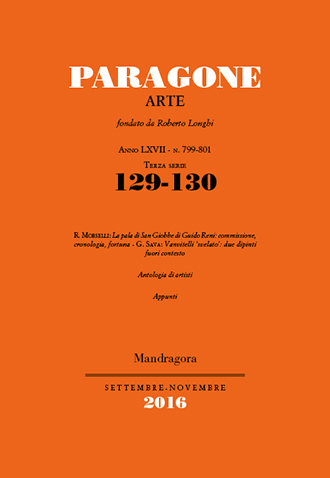Paragone Arte 129-130

Anno LXVII – Terza serie – Numero 129-130 (799-801) Settembre – Novembre 2016
Raffaella Morselli: La pala di San Giobbe di Guido Reni: commissione, cronologia, fortuna
Giuseppe Sava: Vanvitelli ‘svelato’: due dipinti fuori contesto
ANTOLOGIA DI ARTISTI
Pratiche del disegno nella bottega di Domenico Ghirlandaio e un’aggiunta al suo catalogo (Matteo Gianeselli)
Tommaso Laureti: un nuovo disegno e qualche osservazione sul suo primo soggiorno romano (Marco Simone Bolzoni)
Un ‘San Matteo e l’angelo’ di Juan Bautista Maino (Gianni Papi)
“La grazia delle ali onde veste gli Angioli”: due inediti bozzetti di Ludovico Gimignani (Silvia Benassai)
Un Pier Dandini ritrovato: la pala del monastero di San Giorgio a Lucca (Michel Scipioni)
APPUNTI
Francesco Arcangeli tra opera e comportamento (Pasquale Fameli)
SUMMARY
RAFFAELLA MORSELLI
The San Giobbe altarpiece by Guido Reni, painted for the third chapel on the left in the church of Santa Maria dei Mendicanti in Bologna (and now in Notre-Dame, Paris), has a complex history. This began with the commission, which stretched from 1622 to 1637, followed by an unstable critical history involving discordant local sources, enormous success in the 1700s (especially in France), oblivion in the 1800s, and less than brilliant scholarly research in the 1900s. The article seeks to reconnect the threads of this story, using rediscovered seventeenth-century references, a study of a substantial number of copies of paintings, drawings and prints that used the altarpiece as the ultimate model, and finally offers a stylistic reading of the painting showing that it was the first of a series of four that Reni executed over a period of a little over six months.
GIUSEPPE SAVA
This article presents two magnificent altarpieces by Luigi Vanvitelli, housed in the Franciscan church in Cles, in the Trentino, but acquired in Rome in the years 1774-1776. Stylistically identifiable as by the great painter and architect, these canvases have eloquent parallels within the artist’s graphic oeuvre. A number of clues and the evidence of early sources indicate that they came from the Roman church of Santi Alessandro e Bartolomeo dei Bergamaschi, in which Francesco Milizia mentions paintings by Luigi that have never been identified. The rediscovery of these early works, roughly datable to between 1728 and 1732, fills a significant gap in our knowledge of Vanvitelli as painter, and helps clarify the figurative aspects that shaped his art.
MATTEO GIANESELLI
The author presents several unpublished sheets, emphasising the importance of the practice of drawing as part of the evolution of a uniform language within Domenico Ghirlandaio’s workshop. The custom of transmitting models and the re-use of certain motifs are studied through autograph sheets by Domenico which resemble certain contemporary drawings by Leonardo da Vinci.
MARCO SIMONE BOLZONI
Sicilian by birth, Tommaso Laureti (1530-1602) had a long professional career in Bologna and Rome. Although he was a prolific painter, fountain designer and active member of the Accademia di San Luca, Laureti is not well known as a draughtsman. The small number of securely-attributed drawings by the artist can now be expanded with the publication of this new work, catalogued among the anonymous sheets in the Musée du Louvre, which is a preparatory study for a still little-known Martyrdom of Saint Catherine.
GIANNI PAPI
The author presents an unpublished painting by Juan Bautista Maino of Saint Matthew and the Angel, identifying it as a very early work by the Spanish artist. The work appears to date from during or immediately after Maino’s Italian sojourn, which probably ended in the summer of 1610. The date is also supported by how the composition relates to the second version of Caravaggio’s Saint Matthew and the Angel in San Luigi dei Francesi, Rome.
SILVIA BENASSAI
The article presents two unpublished bozzetti by Ludovico Gimignani. The first, representing The Holy Trinity in Glory, can be recognized as a preparatory sketch for the frescoed soffit in the Roman church of Santa Rita da Cascia alle Vergini (formerly called Santa Maria delle Vergini). The second, a God the Father in Glory with Angels in Flight, was also conceived as a modello, designed for the decoration of a small dome, but never carried out by Ludovico; the design for the project appears in a detailed preparatory drawing in the Istituto Centrale per la Grafica, Rome.
MICHEL SCIPIONI
Pietro Dandini painted two altarpieces for the Dominican convent of San Giorgio in Lucca. While the first remains untraced, the second – an unpublished canvas of The Virgin of the Rosary with Saints Dominic and Catherine of Siena – has been identified in the Dominican convent of Santa Maria del Sasso in Bibbiena, which it reached after tortuous journeys that began with the suppression of religious establishments in Tuscany. The artist was paid 60 scudi for this work, which was made for the altar of San Giorgio, where it was placed on 20 August 1700.
The painting appears to be one of best made during the artist’s mature period, and can be added to other masterpieces of his in the Casentino.
PASQUALE FAMELI
Between the end of the 1960s and the early 1970s, artistic evolution has seen the emergence of poetics centred on the corporeal and on the relationship of the individual to the surrounding world, variously defined by the labels Anti-form, Arte Povera, Body Art, and Conceptual Art. Francesco Arcangeli was no stranger to these phenomena, and contributed significantly to their critical reception. A thorough review of his observations, as found in texts written between 1967 and 1972, now enables us not only to understand the reasons for his interest in those movements, apparently so extraneous to his own interests, but also to re-read Arte Povera from an existential, rather than ideological, point of view, thus revealing a full expression of its aesthetic values.
